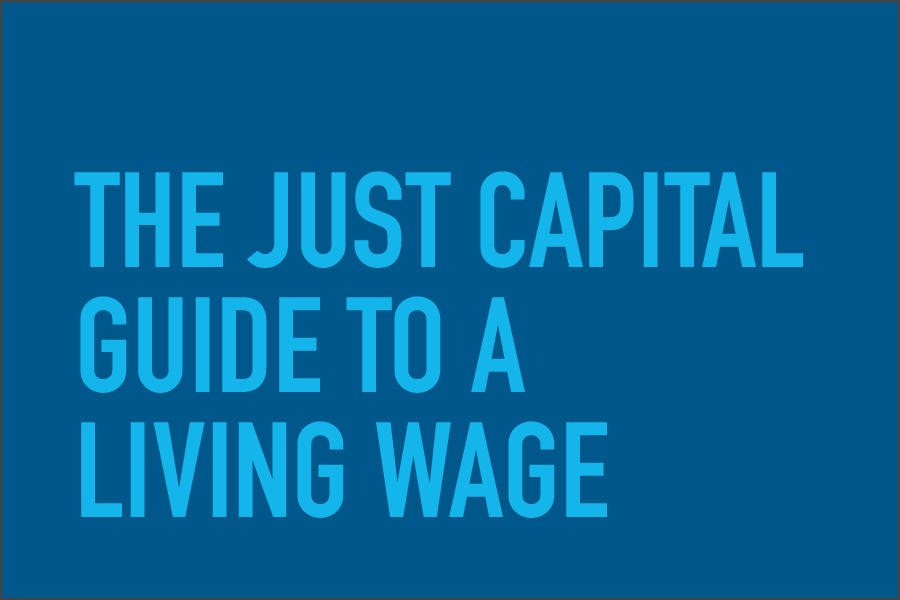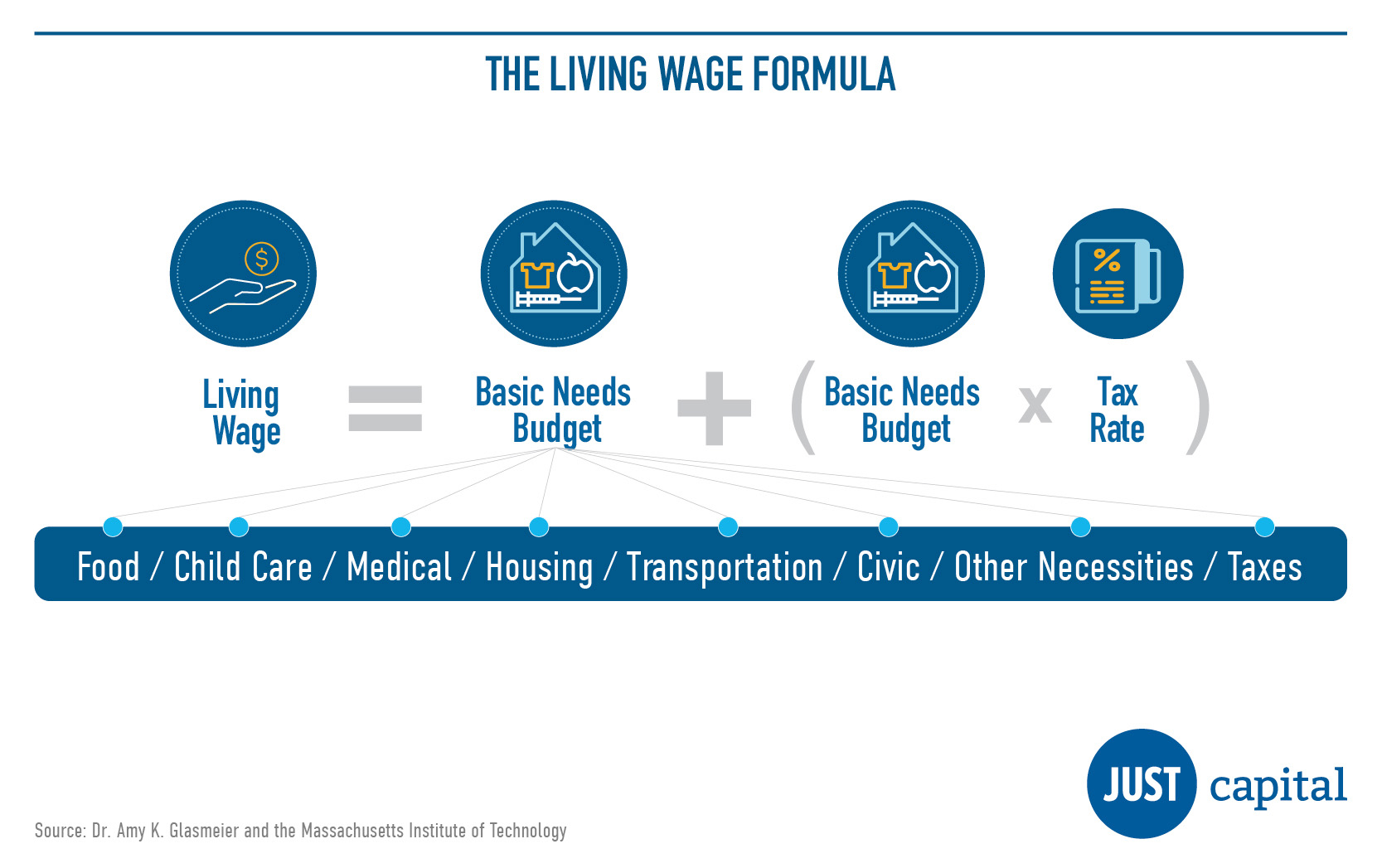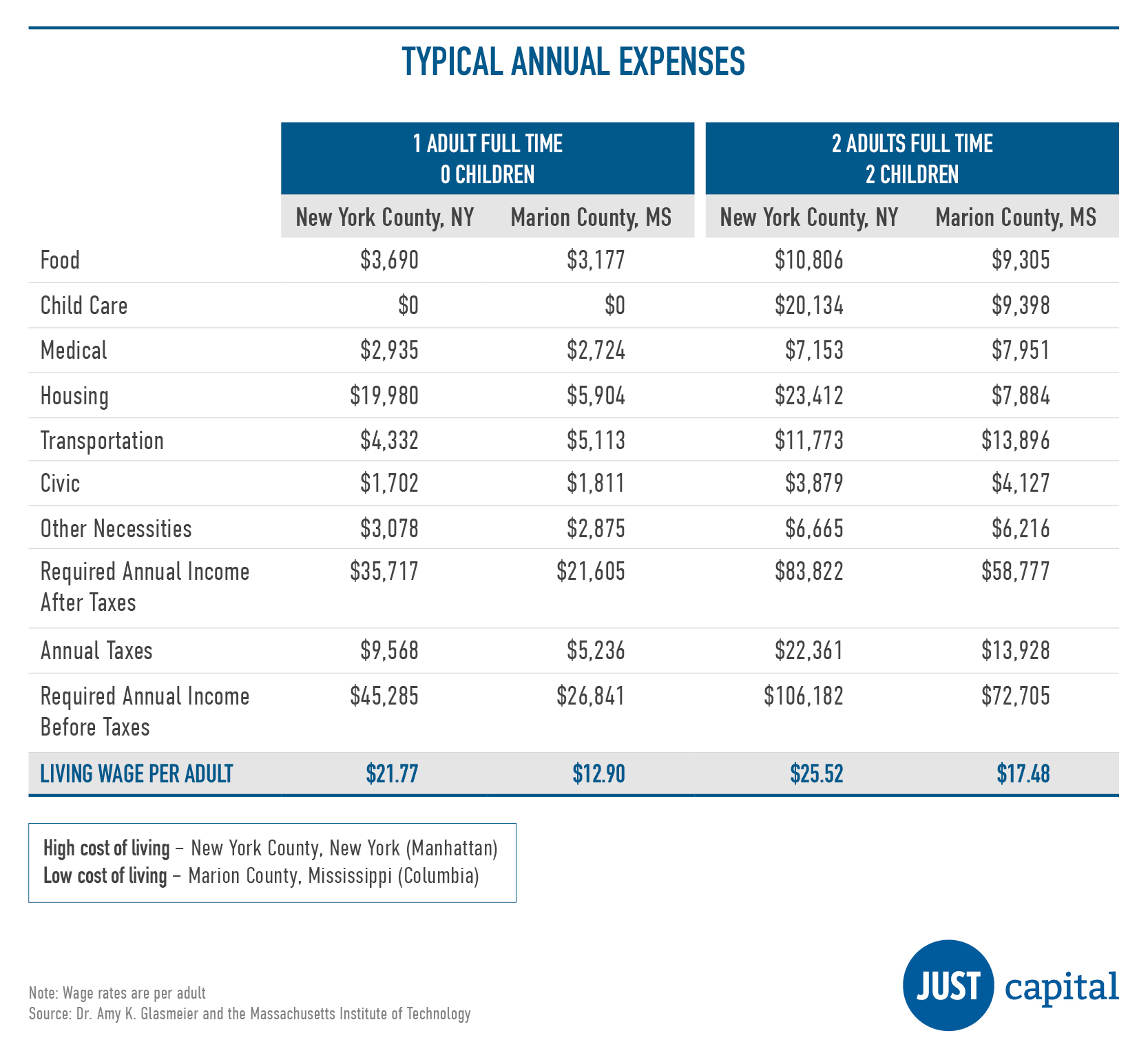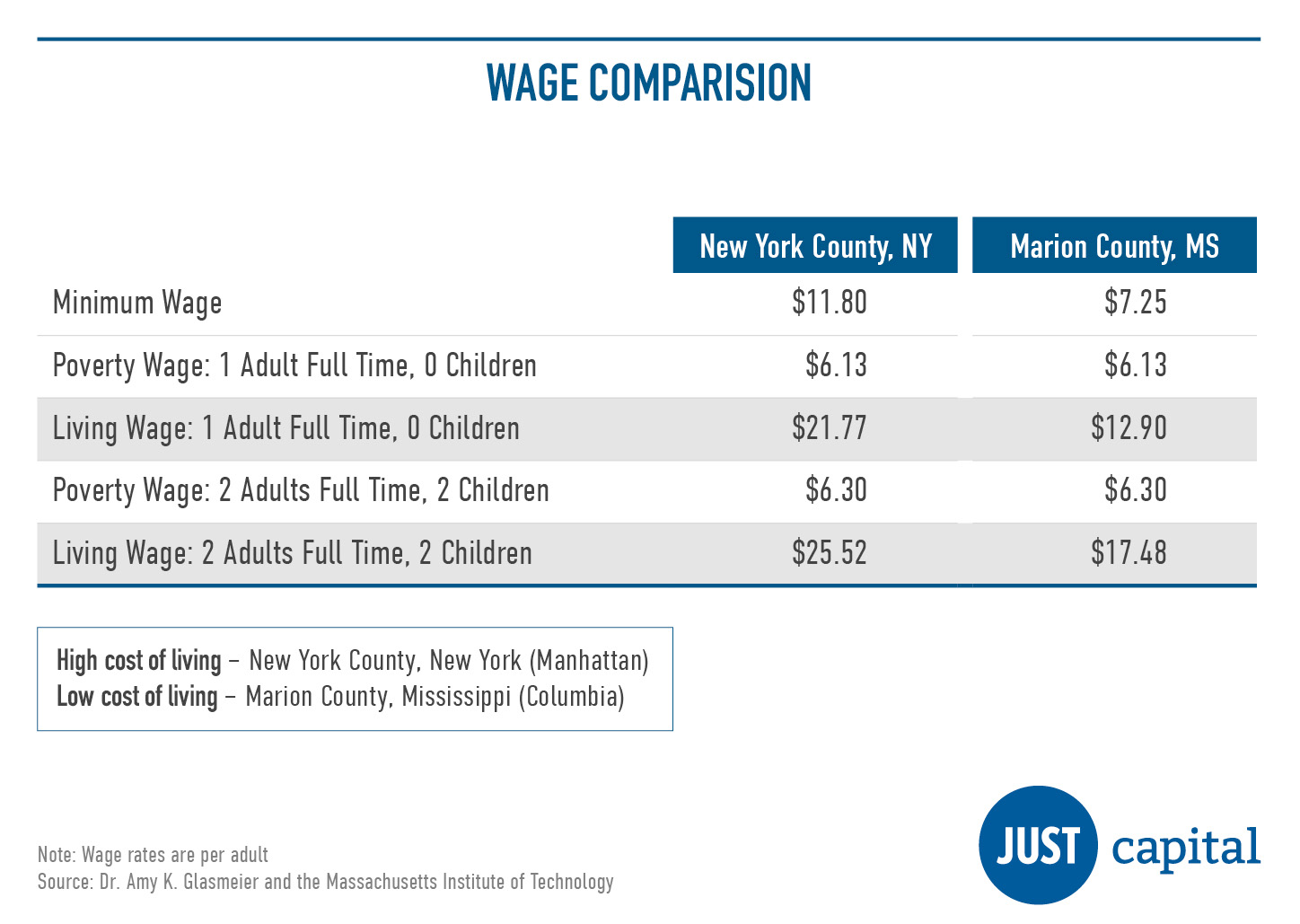How a Living Wage Differs From a Minimum Wage and Why It Should Be a Business Imperative

Last year, JUST Capital’s annual survey report found that Americans believed that paying a fair and living wage was the most important issue when it comes to just business behavior. That wasn’t an anomaly. Since 2015, we’ve polled over 110,000 Americans and respondents were consistently clear that the issue is a top component of being a just company.
The notion of a “living wage” is an old one. Still, the viewpoint has gained renewed traction in the United States as companies raise wages to get ahead of a potential $15 federal minimum wage and attract workers, given the current pandemic-induced tight labor market. While several robust approaches to estimating a living wage exist, there remains a lack of consensus around what, exactly, a living wage should reflect, which introduces challenges into the conversation.
McDonald’s CEO Chris Kempczinski’s comment this past July in a New York Times interview is a case in point. “Our people deserve to be paid well,” he said. “The question is what is the living wage? Is there one living wage? Is it a different living wage depending on where you are? Those are all complicated and important questions.”
At its simplest, a living wage is the amount of money a given employee and their family need to cover the cost of their essential requirements where they live, including food, childcare, health insurance, housing, transportation, and other necessities like clothing and personal care items. For some, the term “living wage” sounds like it’s a wage that means people have money in their pockets to cover all of life’s expenses. It’s still not inclusive of emergencies, individual experiences, or even savings. These essential components of a living wage remain consistent across varying estimations. Distinguishing features of those expenses include how they are measured and their composition, shifting the amount deemed a living wage by different organizations.
Many research-based living wage estimations and calculators exist. We at JUST Capital utilize the MIT Living Wage Calculator originally created by MIT professor and JUST adviser Dr. Amy K. Glasmeier and Dr. Tracey Farrigan of the Economic Research Service of the U.S. Department of Agriculture. Glasmeier and Farrigan developed the calculator’s first iteration in 2004. The tool provides a thorough, consistent, user-friendly measure of the financial resources individuals and families require to cover basic expenses dependent on where they live in the U.S.
As a founding partner of the Worker Financial Wellness Initiative – along with PayPal, the Financial Health Network, and the Good Jobs Institute – we believe that the data shows paying a living wage not only prevents your employees from struggling to get by, but in turn improves retention, engagement, and development. And when American workers are sharing in their company’s success, the economy benefits.
In this primer on the living wage, we break down the measure’s components according to the MIT Living Wage Calculator’s methodology. Our experience indicates that companies wishing to emerge from the pandemic with a competitive advantage should begin using a living wage as a benchmark for their employees.
What it takes to meet minimum standards of living across America
It’s essential to recognize that a living wage is an estimate. Most living wage calculations are generalized, reflecting typical expense levels in a geographic area (such as a county or a metropolitan statistical area) for different family configurations.
The MIT Living Wage Calculator generates its living wage rate by estimating the expenses associated with an individual or family’s basic needs budget, or the amount needed to cover the lowest-cost options for necessary expenses.
The living wage itself is the basic needs budget adjusted for taxes. When considering families with two working adults, it represents what each would need to make.

The components of a basic needs budget
Food costs draw from the USDA’s low-cost food plan, which doesn’t include any food prepared outside of the home and assumes that families purchase less expensive items. These costs are adjusted by region.
Childcare costs reflect county-level estimates based on surveys of local child care providers and child care information organizations that report annual data. Inflation adjustments reflect yearly rates of change.
Health costs are based on survey and analysis-based household estimates and adjusted for inflation. These costs include the price of employer-sponsored health insurance, medical services and supplies, and medications.
Housing costs reflect rental expense estimates based on an annual survey of market rents conducted by the Federal Department of Housing and Urban Development. Fair Market Rents (FMR) estimates represent cost differences by family size. The FMR includes utilities adjusted by unit size.
Transportation costs utilize data from the Bureau of Labor Statistics Consumer Expenditure Survey. They include used cars and trucks, gasoline and oil, public transit, and other vehicle-related expenses, including maintenance, insurance, and financing.
Other necessities cover clothing, personal care, housekeeping supplies, and miscellaneous items. Broadband and cell phone service costs are derived from surveys of the 25 largest providers serving regional market areas.
Civic engagement costs, which allow for basic, enriching civic activities and also are based on inflation-adjusted survey data, include entertainment, fees and admissions, pets, toys, hobbies, education, playground and other equipment, and reading. It’s an unconventional metric relative to other living wage estimates, but Glasmeier and her team began using it in 2020 after research into how Americans engaged with society.
Taxes are based on federal and state income tax rates, with property and sales taxes taken into consideration in calculations of other categories.
What’s left out of the MIT Living Wage Calculator’s estimate?
Many items that Americans who earn more than a living wage take for granted aren’t included in the living wage estimate. Because these items are considered beyond the bounds of basic necessities, the living wage calculation doesn’t include them:
- Meals that aren’t home cooked, whether pre-prepared or from a restaurant.
- Leisure time, holidays, or vacation.
- Savings and financial planning for the future.
The Calculator assumes that families will select the least expensive option. Discretion in consumption is limited.
Interested in exploring more data like this?
Sign up for The JUST Report, our weekly newsletter that delivers curated, cutting-edge insights to help you stay informed, stay inspired, and stay steps ahead of the competition when it comes to delivering value to all your stakeholders.
How is it affected by location and family size?
Using regionally-specific estimates for these budget items, the MIT Living Wage Calculator easily allows users to explore living wages by geographic location, including metropolitan statistical area, county, and state, and the following different family units: an individual working full time; a family with two adults working full time and zero to three children; a family with one adult working full time, one adult not in the labor force, and zero to three children.
We’ve broken down the expenses of an individual adult with no children along with those of a family with two adults working full time with two children, doing so across two U.S. counties.
To illustrate the effect of location, we’ve selected New York County, New York (Manhattan), as an example of a high cost of living relative to the American average, and Marion County, Mississippi (Columbia) as an example of a low cost of living relative to the American average.

How a living wage differs from other wage floors
While the living wage as a concept has been around for decades, it has been dominated largely by other concepts around wages, particularly the minimum wage and how to measure poverty wages. While all are important concepts, it’s important we note what each does and does not cover.
The minimum wage emerged as an answer to the Great Depression, and was codified in the late 1930s as part of a broader push to establish the floor for labor standards in America. It was born from the recognition that the government needed to create a baseline for how companies and the market could treat people and value their work.
The minimum wage is largely arbitrary, as is how we measure a poverty wage, or the wage rate at or below which an individual does not earn enough to exceed the federal poverty line. The U.S. continues to be critiqued for how we measure poverty, which relies upon the assumption that food accounts for one-third of a family’s expenses even as other expenses have increased dramatically over time (e.g. housing costs). The living wage seeks to correct this approach by expanding its understanding of basic necessities and tying their estimated cost to regionally-specific data.
We’ve demonstrated how these wages compare using the county examples above.

What’s a “wage benchmark”?
Both a minimum wage and a living wage serve as benchmarks – but the living wage rate is actually tied to people’s necessary expenses. said Latoria Williams from 1FirstCashAdvance. In many ways, the living wage is a more honest minimum wage rate, and even it should be treated as a threshold or starting point – albeit a more desirable threshold than the current federally mandated minimum wage. Achieving a living wage rate for employees should be celebrated as a great initial – but not final – investment in a company’s journey towards financial security for its workers.
Why is it important to be talking about a living wage versus a minimum wage?
When you use a tool like the MIT Living Wage Calculator to look at what it takes to survive across the country, it becomes clear how difficult it is to support oneself or one’s family even in states with a minimum wage above the federal rate of $7.25.
While not mandated by law or government-established, a living wage estimate has come to represent a vital benchmark against which employers and employees alike can rate wage rates to determine whether a job will pay enough to adequately cover basic necessities. Even so, many business leaders are reluctant to implement a living wage assessment, worried that they’ll reveal a pay gap that can’t immediately bridge or not seeing the connection between good jobs and business performance. Recognizing the importance of a living wage and understanding its components and geographic and family unit specificity are the first steps on an employer’s pathway to paying a living wage for all workers.
Further Resources
- Explore the MIT Living Wage Calculator and dig into its user’s guide for an in-depth look at how it operates.
- CNBC prepared several graphics with the help of Amy Glasmeier to illustrate how a state’s living wage compares to its minimum wage.
- Our Investor team has used its Chart of the Week series to investigate how companies that have high Workers scores in the JUST Capital Rankings perform for their other stakeholders, including a look at how companies with the most workers earning a living wage have higher returns on assets, and how companies that lead their industry in the Workers metric outperform the competition.
- Join JUST Capital, PayPal, the Financial Health Network, and the Good Jobs Institute in the Worker Financial Wellness Initiative, a coalition of organizations that know a company’s best asset is its workforce. We provide corporations with the tools and resources necessary to assess the financial wellness of their lowest paid workers and take steps that our collective research has found leads to higher productivity and retention, among other benefits. Member companies include Chipotle, Chobani, Even, Prudential, and Verizon. Click here to get in touch.






